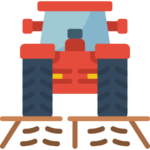Farming Equipment
Farming equipment plays a crucial role in the agricultural industry, helping farmers grow crops, raise livestock, and manage their land more efficiently. Various types of equipment are used for various purposes, ranging from tilling the soil to harvesting crops and transporting produce. Here are some commonly used farming equipment:
Soil Preparation Equipment
1. ** Tillers**: Tillers are used to break up the soil and prepare it for planting. They incorporate organic matter, remove weeds, and create a uniform seedbed.
2. Cultivators: Cultivators, also known as rotary tillers, are used to maintain and cultivate the soil in rows or furrows. They help remove weeds, loosen compacted soil, and mix fertilizers or soil amendments.
3. Plows: Plows are heavy-duty pieces of equipment that are used to till the soil deeply. They are commonly used in large-scale farming operations to break up hard-packed soil and remove rocks.
Planting Equipment
1. Seed Drills: Seed drills are specialized machines that plant seeds with precision. They evenly distribute seeds at a specific depth and spacing.
2. Planters: Planters are machines that sow seeds or plant seedlings directly into the soil. They come in different configurations, including row planters and bed planters.
3. Spreaders: Spreaders are pieces of equipment used to apply fertilizers, pesticides, or other nutrients to crops. They are equipped with mechanisms that evenly distribute the substances over the area.
Irrigation Systems
1. Sprinkler Systems: Sprinkler systems are commonly used to irrigate crops in row crops or orchards. They use a series of sprinklers or nozzles to water the plants at a predetermined schedule.
2. Drip Irrigation Systems: Drip irrigation systems deliver water directly to the plant roots, minimizing evaporation and runoff. They are commonly used in greenhouses, nurseries, and vegetable gardens.
Harvesting Equipment
1. Harvesting Machinery: Harvesting machinery includes combine harvesters, forage harvesters, and balers. These machines help collect crops, such as grains, fruits, and vegetables, from the field.
2. Post-Harvest Equipment: Post-harvest equipment includes grain dryers, threshers, and processing equipment. They are used to prepare harvested crops for storage, milling, or packaging.
Transportation Equipment
1. Tractors: Tractors are multi-purpose vehicles used in farming operations. They tow implements, such as plows, planters, and sprayers, and are used for pulling trailers and transporting heavy loads.
2. Trailers: Trailers are used to haul various farming materials, such as fertilizer, seed, and equipment. They come in various sizes, ranging from small utility trailers to large semi-trailers.
Safety Equipment
1. Safety Helmets: Safety helmets are necessary to protect farmers from head injuries while working around farming equipment. They should always be worn when operating machinery or working in hazardous areas.
2. Gloves: Protective gloves are essential to prevent cuts, abrasions, and skin irritations while handling sharp tools or working with hazardous materials.
3. Eye Protection: Eye protection, such as safety glasses or goggles, should be worn to prevent eye injuries caused by dust, debris, or chemicals.
Conclusion
Farming equipment has evolved significantly over the years, enabling farmers to enhance productivity, improve efficiency, and maximize crop yields. From soil preparation equipment to harvesting machinery and transportation vehicles, these tools are essential for modern agricultural practices. By investing in the right equipment, farmers can optimize their farming operations and ensure that their operations are sustainable and successful.


